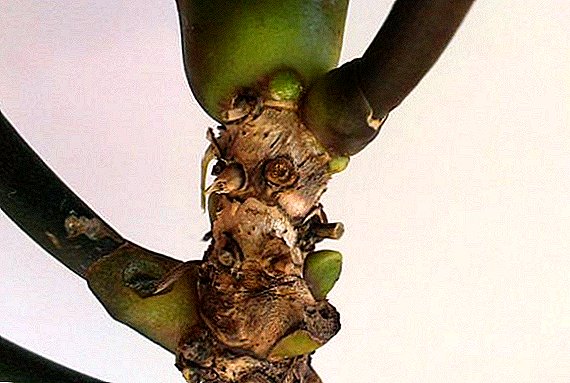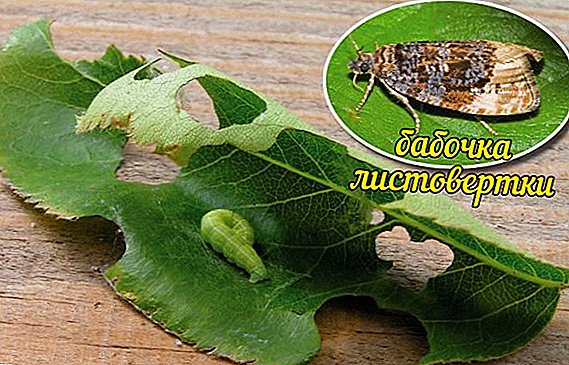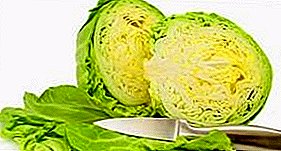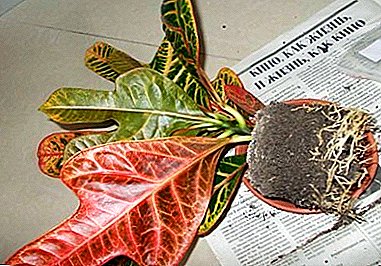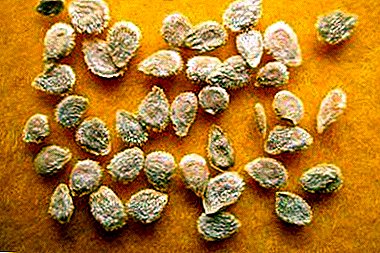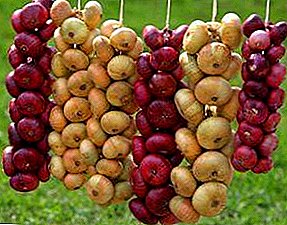 The name "Loch" covers several dozen different trees and shrubs with beautiful silver leaves. China is the birthplace of the plant, although it was also widely distributed in North America. In our area, the Loch is quite rare, which is definitely a special attraction.
The name "Loch" covers several dozen different trees and shrubs with beautiful silver leaves. China is the birthplace of the plant, although it was also widely distributed in North America. In our area, the Loch is quite rare, which is definitely a special attraction.
In addition to the decorative properties, these plants are very rich in beneficial micro and macro elements and are even called "silver berries" or "wild olives". Silver Lox fruits are edible and useful, but they are not very popular, since the main part of the berry is occupied by the stone, and the pulp is too small.
The most common representative of the family is Loch Silver - shrub with elegant spreading crown, especially beautiful during flowering. Scientists are constantly deriving new and new forms of this plant, so we can expect that soon it will become even more widespread in our latitudes. A lot to contribute to this should be the fact that the silver sucker does not at all create problems for growing and does not require special care.  An additional advantage when planting this shrub at the dacha is that the silver sucker is an excellent honey plant. During the flowering period, which can last up to a month, the plant literally exudes a pleasant honey aroma that resembles the smell of sea buckthorn, which bees and other insects fly with pleasure to.
An additional advantage when planting this shrub at the dacha is that the silver sucker is an excellent honey plant. During the flowering period, which can last up to a month, the plant literally exudes a pleasant honey aroma that resembles the smell of sea buckthorn, which bees and other insects fly with pleasure to.
Did you know? Honey from the flowers of the silver sucker is very fragrant and tasty and, in addition, hypoallergenic. Already proven positive effect that this honey has on the vessels of the brain, improving its work. It also stops the inflammatory processes in the body, promotes the removal of harmful substances, restores the liver and has a restorative effect.
Best time to land
The time for planting a silver sucker depends on the chosen method of its reproduction: seeds are usually planted in autumn (less often in spring), the division by layering is carried out in early spring, cuttings - in early summer.
As for planting seedlings, two options are possible: early spring or late autumn. The main thing is that by the time of planting the soil is as filled with moisture as possible, since the plant, especially at the initial stage, is in dire need of it.
Site selection and soil preparation
 The sucker silver belongs to the light-loving plants, but in the penumbra can also develop well. The best place for a seedling will be a hill on the southern side of the site, if possible, protected from sudden gusts of wind by a structure, fence or other structure.
The sucker silver belongs to the light-loving plants, but in the penumbra can also develop well. The best place for a seedling will be a hill on the southern side of the site, if possible, protected from sudden gusts of wind by a structure, fence or other structure.
To the composition of the soil, this shrub is not too picky, the only condition - the soil should not be too acidic, as it will have a bad effect on the development of the shrub.
Therefore, if necessary, the excess acid must be neutralized in advance by adding lime or dolomite flour to the soil. If the ground is heavy and swimming, it will be useful to add sand to it to facilitate and give greater looseness.
Did you know? A distinctive feature of the silver-sucker is that its roots are the habitat of specific nitrogen-fixing bacteria, so that the plant can not only develop on non-enriched soils, but also improve their composition and structure.Preparing the soil for planting a silver sucker includes deep digging, careful leveling, as well as careful removal of debris, roots and weeds. The silver sucker has a root system of a fibrous type, which does not go deep into the ground; therefore, proper treatment of the surface soil layer before planting has a great influence on the subsequent development of the young plant.
Planting young seedlings
Agrotechnics planting seedling Loch silver suggests preparing a pit 0.5 m deep and 0.5-1 m in diameter (depending on the size of the seedling); drainage is placed at the bottom of it (sand, screenings, crushed stone or other material can be used for this purpose, which can protect the seedlings from rotting due to stagnation of water), and then a layer of fertile soil extracted from the pit, mixed with compost, humus or sheet soil. You can add a little wood ash to the soil and 0.2-0.3 kg of double superphosphate. 
Then a sapling is placed in the pit and gently sprinkled with the remaining soil so that the root neck is 5-8 cm deep. The dumped hole is lightly trampled down, watered abundantly and mulched to preserve moisture and weed control. The distance between seedlings should be at least two meters.
Care in the process of growing the silver sucker
Further care of the silver sucker does not present any particular difficulties. This plant is not only unpretentious to the composition of the soil, but is also not affected by the pests and diseases that are most common in our climate zone. In order for the plant to develop well, it is enough to observe the conditions of irrigation and loosen the soil around the trunk (the last procedure can be avoided if the area has been previously ground with dry grass or sawdust).
Watering bushes
The silver sucker is considered a drought-resistant plant, and yet it endures a long drought poorly, especially at a young age. This is due to the peculiarity of the structure of the plant's root system: being located near the surface, the roots cannot reach the deep layers of the soil and independently obtain moisture.  Therefore, the lack of fluid due to the long absence of rain or too high temperature must be filled with moderate watering, while avoiding stagnation of water in the soil (surface roots of the sucker may undergo rotting processes).
Therefore, the lack of fluid due to the long absence of rain or too high temperature must be filled with moderate watering, while avoiding stagnation of water in the soil (surface roots of the sucker may undergo rotting processes).
Top dressing
Especially feeding the shrub is necessary only on very depleted and infertile soils. Usually fertilizers applied simultaneously with planting are sufficient for the normal development of the sucker throughout the year. Later, once a season, you can feed the shrub with organic matter (wood ash, compost, humus) and, if desired, double superphosphate. Loss silver does not need nitrogen fertilizers.
Trimming and Shaping
The sucker silver has a significant drawback - slow growth. However, if the soil is fertile, the plant can increase in height to half a meter per season and even more. It tolerates pruning and crown formation well, therefore, depending on the desire of the gardener, the plant can be designed as a stem tree, or it can be kept in the form of a shrub. 
As with people, the “haircut model”, which fits best into the design of your particular site, should be selected in advance, having thoroughly studied the photos of the most successful options for the formation of a sucker.
Important! In addition to forming haircuts, shrubs that have reached 15 years old should be radically cut to rejuvenate. This will allow the plant to maintain the freshness and decorative appearance of another 10-15 years without transplanting.Finally, the silver sucker, slowly evolving in height, is very actively releasing root processes. If they are not trimmed in time and not controlled, the shrub quickly begins to lose its decorative appearance, turning into untidy and neglected thickets.
Wintering sucker bushes silvery
The sucker silver is a frost-resistant plant: the cold it suffers much better than drought, therefore, it is necessary to think about the special preparation for winter only in the first year after planting the seedling in open ground, since the plant can really freeze before a firm rooting. 
To protect the bush from frost, it is enough to cover it with needles, brushwood or other material for the winter. If the winter is snowy, you can nest a snowdrift around a young bush, this will save it from frost and provide moisture in the spring. However, in this case, it is imperative to make sure that the snow around the bush does not melt and does not become covered with ice.
In more severe climatic conditions, it is worth covering the silver sucker bushes not only in the first winter after planting, but also in subsequent years.
Use in landscape design
The silver sucker is a very beautiful shrub. Its original foliage of a metallic shade rests on branches, without changing color, almost until winter, but even after it has fallen, the large silver fruits remaining on the shrub give it a new unique charm.
Moreover, unlike other deciduous plants, the silver sucker retains its amazing decorative qualities even in winter, thanks to its strong branching and elegant lines, the plant does not look bare and lonely, especially if it is shaded by evergreen trees. 
Did you know? The silver sucker is much better than many other shrubs; it tolerates the negative environmental conditions of megacities, smoke and plenty of dust. This feature allows you to plant it on noisy city streets, as well as along or on the dividing lane of motorways, where other plants quickly wither and develop poorly.Of all the plants with silver leaves, the sucker, perhaps, is the highest, which determines the various variations for the use of the plant in landscape design. This shrub can play the role of self-decorating the site or be included in the ensembles and compositions.
The silver sucker, thanks to the decoratively decorated crown, beautiful metallic shade of leaves and fruits, can add fashionable bright colors to the garden or flower garden design, which will be especially interesting if you plant it next to plants that have flowers or leaves of contrasting shades (dark green, red , golden, white).
Very good Loch looks in a group with conifers and shrubs (spruce, thuja, juniper). With the help of the sucker, you can also fix the slopes, to form artificial groves. 
Important! Perhaps the only drawback of this shrub is an excessively abundant root growth. This feature must be considered by landscape designers when trying to use the plant to form hedges. For these purposes, the shrub is practically unsuitable, the only possibility - short radical pruning at a level just above the curb.
Reproduction sucker silvery
The sucker is propagated by silver seeds, as well as by any of the possible vegetative methods: cuttings, layering, dividing the bush, root suckers. 
The most popular way of breeding silver sucker is planting seeds. Sowing can be carried out either in the middle of autumn or in spring, however, the latter method is considered less preferable, since the seeds need to be stratified, otherwise germination is almost zero.
Artificial wintering of seeds can be done in two ways: mix with sand and bury the container in open ground for the winter or store in a cellar at a temperature of several degrees above zero, mixing with peat.
It is best to sow fresh seeds (last year's seedlings are growing much worse). Immediately after planting, the bed is covered with sawdust, fallen leaves, humus or other material to protect the seeds from freezing.
 For reproduction by layering in the spring, in the lower part of the bush, a strong branch is selected, which must be bent down to the ground, fastened and covered with earth. Until autumn, the cuttings should be watered to prevent stagnation of water, after which the plant can be separated from the parent.
For reproduction by layering in the spring, in the lower part of the bush, a strong branch is selected, which must be bent down to the ground, fastened and covered with earth. Until autumn, the cuttings should be watered to prevent stagnation of water, after which the plant can be separated from the parent.
As cuttings you need to select the shoot length of about 15 cm with a small amount of buds (4-5), process it with a growth stimulator, bury it in a box with wet sand and periodically water it to avoid drying. The procedure is carried out in early summer, and in the fall the box is transferred to the cellar for the winter. By spring, the stalk will take root, and it can be planted in a permanent place.
Important! Cuttings - not the most effective way of breeding sucker silvery. Even experienced professionals take root no more than a third of shoots.In general, it can be said that the silverfish is undemanding in its care, it takes root in almost any soil (except acidic), it tolerates poor ecology, severe winters and a slight lack of moisture. At the same time, the plant is very decorative, is a magnificent honey plant, and, in addition, it is able to improve the structure of the soil and enrich it with nitrogen. At one place, with proper pruning and timely removal of root shoots, the bush can remain attractive for over 25 years.


